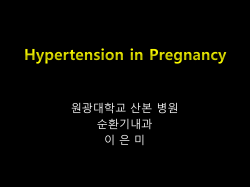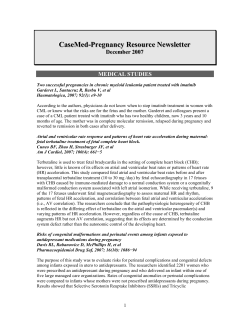
Special Populations: Pregnancy and Breastfeeding Joanne C. Witsil, RN, PharmD, BCPS
Special Populations: Pregnancy and Breastfeeding Joanne C. Witsil, RN, PharmD, BCPS Clinical Pharmacist, General Medicine/Surgery and Family Medicine John H. Stroger Jr. Hospital of Cook County Adjunct Clinical Assistant Professor University of Illinois at Chicago, College of Pharmacy Scenario 1 A 28 year old female walks into your practice setting with a prescription that she received 4 days ago from another Practitioner for complaints of a urinary tract infection (UTI) RX written as Ciprofloxacin 500 mg po every 12 hours for 7 days Objectives Describe the maternal changes that occur during pregnancy and how they affect drug absorption, distribution, metabolism and clearance Explain the characteristics of the placenta and lactation that impact drug distribution State the 5 pregnancy categories Discuss the current treatment regimens for pregnant patients exposed to a biological, chemical or nuclear event Stages of Pregnancy First trimester (weeks 1-12) Organogenesis occurs especially 5-10th week AKA: Second trimester (weeks 13-26) Organs become functional AKA: embryonic period (first 8 weeks) fetal period (actually starts week 9) Third trimester (weeks 27-40) AKA: fetal/perinatal period Dipiro JT, et al. Pharmacotherapy, A pathophysiologic approach. 5th ed. Chapter 78. Katzung BG, et al. Basic & Clinical Pharmacology. 7th ed. Chapter 60. Pregnancy Physiological changes General Changes Susceptibility to infections are altered Overall, diminished cell-mediated immunity Specifically, neutrophil chemotaxis, adherence and natural killer cell activity are decreased Mother and fetus are at greater risk for infections White SR, et al. Emerg Med Clin N Am 2002:20;365-92. Maternal Pharmacokinetic Changes Absorption Gastrointestinal tract (GIT) motility reduced Increased gastric pH Increased pulmonary alveolar drug uptake Key point: May lead to increased drug absorption Dipiro JT, et al. Pharmacotherapy, A pathophysiologic approach. 5th ed. Chapter 78. Distribution Plasma volume increases by 50% 40% distributed to maternal compartments 60% distributed to amniotic fluid, placenta, fetus Serum albumin level Decreases as weeks of gestation increase Key point: more unbound or free drug in circulation Especially drugs bound to serum albumin Dipiro JT, et al. Pharmacotherapy, A pathophysiologic approach. 5th ed. Chapter 78. Metabolism Increased progesterone and estradiol concentrations affect hepatic drug metabolism Clearance Either increased or decreased Renal blood flow and glomerular filtration rate is increased by 25-50% Key point: appears these changes do not have clinical significance therefore no dose adjustment! Dipiro JT, et al. Pharmacotherapy, A pathophysiologic approach. 5th ed. Chapter 78. Placental Characteristics Historically Placenta was once thought of as a barrier Fundamentally By 5th week of gestation it fully functions as a transporter between mother and fetus Most drugs move across membranes by passive diffusion Mother to fetus and then once maternal serum levels decline back to mother from fetus Dipiro JT, et al. Pharmacotherapy, A pathophysiologic approach. 5th ed. Chapter 78. Specifically Maternal transplacental considerations Maternal dose Route of administration Maternal pharmacokinetics Drug transplacental considerations High lipophilicity Low ionization Low molecular weight Low protein binding Dipiro JT, et al. Pharmacotherapy, A pathophysiologic approach. 5th ed. Chapter 78. Timing of exposure Teratogenicity definition It is the abnormal development of the fetus or fetal organs either structurally or functionally. Abnormalities can include the loss of pregnancy, structural or functional abnormalities and uterine growth impairment Embryonic period (2-8th week of gestation) Greatest potential to cause organ structural damage Fetal period (9th week-full term) More subtle changes in function or behavior Dipiro JT, et al. Pharmacotherapy, A pathophysiologic approach. 5th ed. Chapter 78. Katzung BG, et al. Basic & Clinical Pharmacology. 7th ed. Chapter 60. Lactation Characteristics Entrance into breast milk Drugs enter via passive diffusion (most common) or active transport Amount of drug passing via passive diffusion in most cases is directly proportional to maternal serum concentration In literature may be expressed as milk: plasma ratio (ratio of 1 means equal amount) pH of breast milk is more acidic than plasma Weak basic drugs enter more freely Dipiro JT, et al.. Pharmacotherapy, A pathophysiologic approach. 5th ed. Chapter 78. Briggs GG, et al. Drugs in pregnancy and lactation. 5th ed. Pages xiii-xviiii. Lipophilic drugs enter more freely Concentrate more in hind-milk versus fore-milk Drugs that bind either to the proteins or onto the milk fat globule enter more freely Timing and frequency of Nursing First few minutes of feed vs last Timing of drug ingestion vs onset of feed It is still questionable how much the infant actually ingests! Dipiro JT, et al.. Pharmacotherapy, A pathophysiologic approach. 5th ed. Chapter 78. Briggs GG, et al. Drugs in pregnancy and lactation. 5th ed. Pages xiii-xviiii. FDA Pregnancy Categories Nahum GG, et al. Obstet Gynecol 2006;107:1120-38. Treatment for Bioterrorism No treatment Treatment Outcomes? Outcomes? Quarantine? Adverse drug effects? No Treatment Class A Agent Anthrax Fatality Rates in the General Population Fatality Case Reports in Pregnancy Cutaneous & GI -20-60% 3 cases – all died Inhalation - >80% Plague Bubonic - 60-90% Smallpox Major- 27-30% Minor- ~1% Major- 63% Prior to 25th week- 75% stillbirths >25th week- 60% lost Birth- 50% died within 2 weeks Viral hemorrhagic Fever Ebola- 77% Lassa- 1-36% Ebola- 95.5% Lassa- 30-75% Both had fetal loss reported as 23-66% White SR, et al. Emerg Med Clin N Am 2002;20:365-92. Kadanalo A, et al. CID 2003;36:1343-6. 13/14 – fetal loss 1 report in 1903 – universal fetal loss Hassett DE. J. Reprod. Immunol. 2003;60:13.24. Adapted from www.idph.state.il.us/Bioterrorism/otherlinks.htm No Treatment Class B Agent Fatality Rates in General Population Fatality Case Reports in Pregnancy Brucellosis 5% 1st & 2nd trimester- 43% fetal loss 3th trimester- 2% fetal loss Q Fever Low Spontaneous Abortion 22% Premature birth- 30% Growth restriction- 69% Utero fetal death- 7% Ricin High 1 case report- Infant born with moderate growth retardation & craonio-facial dysmorphia Adapted from www.idph.state.il.us/Bioterrorism/otherlinks.htm. Hellmeyer L, et al. Z Geburtshilfe Neonatol. 2002 Sept-Oct;206:193-198. EL Mauhoub M, et al. Ann Trop Paediat. 1983 Jun;3:57-61. Khan MY, et al. Clin Infect Dis. 2001 Apr 15;32:1172-7. Treatment of Class A and B Bacterial Agents Bacteria Primary Choice Alternative Anthrax Ciprofloxacin or doxycycline and 1 or 2 alternatives rifampin, vancomycin , chloramphenicol, imipenem, clindamycin, clarithromycin, (PCN & ampicillin only once sensitivities confirmed) Plague Gentamicin Ciprofloxacin or doxycycline Tularemia Gentamicin or streptomycin Ciprofloxacin or doxycycline Brucellosis TMP/SMX and streptomycin None given or rifampin Glanders TMP/SMX and ceftazidime if severe disease TMP/SMX or tetracycline or amoxicillin/clavulanate in mild disease Q Fever Doxycycline or tetracycline Quinilones, TMP/SMX chloramphenicol Inglesby, TV, et al. JAMA 2000;283:2281-2290. Adapted from www.idph.state.il.us/Bioterrorism/otherlinks.htm Inglesby TV, et al. JAMA 2002;287:2236-2252. www.cdc.gov *Dosing regimens are the same as for adults. See treatment guidelines available at IDPH or CDC. Most Common Antibiotics Antibiotic FDA Category Placenta crossing Excreted in Breast Milk Amoxicillin B Yes Yes Reported association with necrotizing enterocolitis in newborns Chloramphenicol C Yes Yes BMS, Caution if used near birth, Gray-baby syndrome Ciprofloxacin C Yes Yes Arthropathy Doxycycline D Yes Yes Fetal dental enamel hypoplasia and retarded skeletal growth. Maternal hepatic necrosis Adverse drug reaction* *Related to maternal/ fetal effects in human data. Briggs GG, et al. Drugs in pregnancy and lactation. 5th ed. Nahum GG, et al. Obstet Gynecol 2006;107:1120-38. White SR, et al. Emerg Med Clin N Am 2002;20:365-92. Antibiotic FDA Category Placenta crossing Excreted in Breast Milk Adverse drug reaction* Gentamicin C Yes Yes No ototoxicity or nephrotoxicity reported in human fetuses. 1 case of renal cystic dysplasia Penicillin B Yes Yes No rate of congenital anomalies Rifampin C Yes Yes Some reports of congenital anomalies Vancomycin B Yes Yes No reports of congenital anomalies. 1 report of bradycardia with rapid infusion. *Related to maternal/ fetal effects in human data. Briggs GG, et al. Drugs in pregnancy and lactation. 5th ed. Nahum GG, et al. Obstet Gynecol 2006;107:1120-38. Antibiotic FDA Category Placenta crossing Excreted in Breast Milk Ceftazidime B Yes Yes No increased risk of congenital anomalies Streptomycin D Yes Yes Rare reports of irreversible deafness with fetal exposure Tetracycline D Yes Yes Fetal dental enamel hypoplasia and retarded skeletal growth. Reports of liver toxicity in mother. TMP/SMX (Bactrim) C/D at term Yes Yes Reports of congenital anomalies. Kernicterus if used at birth *Related to maternal/ fetal effects in human data. Adverse drug reaction* Briggs GG, et al. Drugs in pregnancy and lactation. 5th ed. Post-exposure Prophylaxis Bacteria Primary Choice Anthrax Ciprofloxacin or doxycycline Amoxiciliin only after 10-14 days of primary agents Plague Ciprofloxacin or doxycycline Chloramphenicol or tetracycline Tularemia Ciprofloxacin or doxycycline Q Fever Doxycycline or Tetracycline No prophylaxis recommended for brucellosis or glanders. White SR, et al. Emerg Med Clin N Am 2002;20:365-92. Adapted from www.idph.state.il.us/Bioterrorism/otherlinks.htm Alternatives Ciprofloxacin *Dosing regimens are the same as for adults. See treatment guidelines available at IDPH or CDC. Treatment of Class A Viral Agents Virus Primary Choice Alternative Botulism Supportive Antitoxin trivalent (A,B,E) from CDC Smallpox Supportive A few reports show in vitro activity against smallpox by Cidofovir. May consider in severe cases Antibiotics only if secondary bacterial infections Viral Hemorrhagic Fevers Supportive Ribavirin, not FDA approved but could consider in severe cases Adapted from www.idph.state.il.us/Bioterrorism/otherlinks.htm Bronze MS, et al. Curr Opin Investig Drugs. 2003 Feb;4:172-8. *Dosing regimens are the same as for adults. See treatment guidelines available at IDPH or CDC. Most Common Antivirals Antiviral FDA Category Placenta crossing Excreted in Breast Milk Adverse drug reaction* Antitoxin C for A & B ? Unknown Fetal malformations noted in animal studies. Hypersensitivity reactions. Cidofovir C Presumed Yes Presumed Yes Skeletal malformations noted in animal studies. No reports in humans Ribavirin X Presumed Yes No data available Teratogenic effects in nearly all animal studies *Related to maternal/ fetal effects in human data. Briggs GG, et al. Drugs in pregnancy and lactation. 5th ed. Adapted from www.cdc.gov Adapted from www.idph.state.il.us/Bioterrorism/otherlinks.htm Post-exposure Prophylaxis Virus Primary Choice Botulism No prophylaxis Smallpox Smallpox vaccine Viral Hemorrhagic Fevers Adapted from www.idph.state.il.us/Bioterrorism/otherlinks.htm No prophylaxis Alternative Smallpox Vaccine Currently, under “peaceful” times CDC does NOT recommend smallpox vaccine to the following: Pregnant women Women who plan on becoming pregnant in 4 weeks after vaccination Women who are actively breastfeeding, excretion into breast milk unknown FDA pregnancy category C White SR, et al. Emerg Med Clin N Am 2002;20:365-92. www.cdc.gov/smallpox Maternal adverse vaccine reactions Primary vaccinia- vesicle at site of inoculation Encephalitis- a few reports Vaccinia necrosum Fetal complications Congenital defects Viremia Fetal vaccinia Rare but serious complication → fetal loss White SR, et al. Emerg Med Clin N Am 2002;20:365-92. www.cdc.gov/smallpox Chemical Terrorism Types of Nerve Agents Tabun (GA) Sarin (GB) Soman (GD) VX Symptoms Mild/Moderate Include localized sweating, muscle fasciculations, nausea, vomiting, weakness, dyspnea Severe Include unconsciousness, convulsions, apnea, flaccid paralysis www.atsdr.cdc.gov/MHMI/mmg166.html Chemical Treatment Protect yourself Personal Protective Equipment (PPE) If possible Get patient to remove contaminated clothing Place in a plastic bag www.atsdr.cdc.gov/MHMI/mmg166.html Agents Used Antibiotic FDA Category Placenta crossing Excreted in Breast Milk Adverse drug reaction* Atropine C Yes Controversial Some reports of congenital malformations 2-PAM C Unknown Unknown Benzodiazepines D Yes Yes Diazepam is most common Unknown if causes fetal harm Congenital malformations noted, growth retardation, central nervous defects *Related to maternal/ fetal effects in human data. Briggs GG, et al. Drugs in pregnancy and lactation. 5th ed. Protopam Chloride (pralidoxime chloride) package insert. Nuclear Terrorism Radioactive iodine if released into air It enters the body and is quickly taken up by thyroid gland Maternal-fetal exposure Enters expecting mother passes through the placenta → fetus Can be passed through breastfeeding Lower radiation doses are seen in fetus Fetus thyroid glands are at more risk for injury Severe consequences to fetus www.bt.cdc.gov/radiation Growth retardation, malformations, impaired brain function, cancer Treatment Potassium Iodide (KI) Everyone should take it Pregnant women Lactating women How does it work? Blocks radioactive iodine from entering the thyroid Does not protect other parts of the body, ONLY thyroid www.bt.cdc.gov/radiation Dose KI (Pregnant and breastfeeding women) 130mg orally with tablets or Two ml of solution Tablets are 65mg or 130mg Solution- each 1 ml contains 65mg Protects thyroid gland for 24 hours Adverse drug effects Allergic reactions (check if allergic to iodine) GI upset Rashes Inflammation of the salivary glands www.bt.cdc.gov/radiation Scenario 2 A 28 year old female walks into your practice setting with a prescription that she received 4 days ago from another Practitioner for complaints of a cutaneous Anthrax exposure that is confirmed in your area RX written as Ciprofloxacin 500mg po every 12 hours for 60 days Questions? Additional References Kadanali A, et al. CID 2003;36:1343-6. Hellmeyer L, et al. Z Geburtshilfe Neonatol. 2002 SepOct;206:193-8. Article in German. Wong TW. Trop Doc. 1986;16:187-89. Welty TK, et al. West J Med 1985;142:641-46. Ozbay K, et al. Clin Exp Obstet Gynecol. 2006;33:61-62. Giannacopoulos I, et al. Doi:10.1053/jinf.2002.1033,available online at www.idealibrary.com Berkovitch et al. Obstet Gynecol 1994;84:535-38. Moskovitz et al. Am J Gastroenterology 2004 Apr;99:656-61. Czeizel et al. Obstet Gynecol 1997;89:524-28.
© Copyright 2025





















